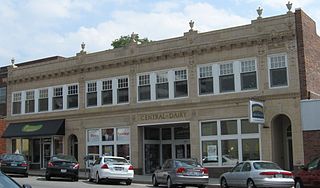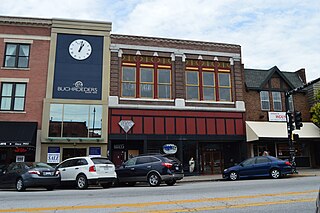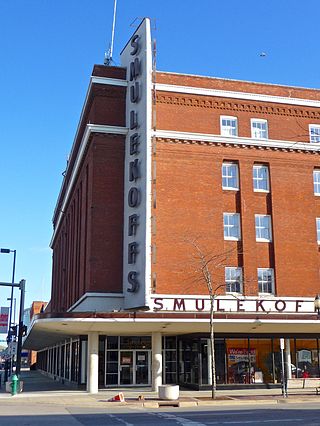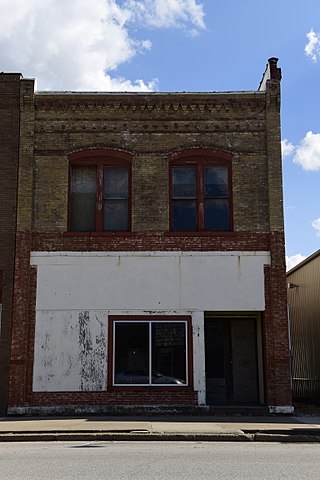
The Ballenger Building, also known as G.F. Troxell Furniture Store, Taylor Music and Furniture Co., and Safeway, is a historic commercial building located in downtown Columbia, Missouri. It was originally built about 1892, and expanded rearward about 1904. It was extensively remodeled in 1928. It is a two-story brick building on a stone foundation. It features terra cotta ornamentation and Chicago school style windows. Today it holds Kaldi's Coffee House.

The Central Dairy Building, also known as Downtown Appliance and Gunther's Games, is a historic commercial building located in downtown Columbia, Missouri. It was built in 1927, and enlarged to its present size in 1940. It is a two-story brick building with terra cotta ornamentation elaborate classical and baroque design motifs. Also on the property is a contributing brick warehouse, constructed about 1940. Today the building houses an appliance store and restaurants on the first floor and lofts on the second.

Downtown Columbia is the central business, government, and social core of Columbia, Missouri and the Columbia Metropolitan Area. Three colleges — the University of Missouri, Stephens College, and Columbia College — all border the area. Downtown Columbia is an area of approximately one square mile surrounded by the University of Missouri on the south, Stephens College to the east, and Columbia College on the north. The area serves as Columbia's financial and business district and is the topic of a large initiative to draw tourism, which includes plans to capitalize on the area's historic architecture and Bohemian characteristics. The downtown skyline is relatively low and is dominated by the 10-story Tiger Hotel, built in 1928, and the 15-story Paquin Tower.

The Kress Building, also known as Kress Wholesale Company Store and Mehornay Furniture Store, is a historic commercial building located in downtown Columbia, Missouri. It was built in 1910 for the S. H. Kress & Co., and remodeled in 1946 when it became Mehornay Furniture. It is a tall two-story, brick building with an open storefront topped by horizontal metal banding, that consists of large plate glass windows.

The Camden Masonic Temple, also known as Mount Zion Lodge #211, is a historic Masonic Lodge located at Camden, Carroll County, Indiana. It was built in 1902, and is a three-story Romanesque Revival style brick and limestone building. It was used historically as a meeting hall, as a specialty store, as a department store, as a professional building, and as a multiple dwelling.

Central Office Building is a historic building located in downtown Davenport, Iowa, United States. It has been individually listed on the National Register of Historic Places since 1983. In 2020 it was included as a contributing property in the Davenport Downtown Commercial Historic District. It is located in the center of a block with other historic structures. It now houses loft apartments.

Peoples National Bank Building–Fries Building are two historic buildings located in downtown Rock Island, Illinois, United States. They were listed together on the National Register of Historic Places in 1999. They were included as contributing properties in the Downtown Rock Island Historic District in 2020. The buildings were built separately, but have subsequently been connected on the first three floors.

The Washington County Courthouse is the name of a current courthouse and that of a historic one in Fayetteville, Arkansas, the county seat of Washington County. The historic building, built in 1905, was listed on the National Register of Historic Places in 1972. The historic courthouse is the fifth building to serve Washington County, with the prior buildings located on the Historic Square where the Old Post Office is today. The building is one of the prominent historic buildings that compose the Fayetteville skyline, in addition to Old Main.
Downtown Monett Historic District is a national historic district located at Monett, Barry County, Missouri. It encompasses 35 contributing buildings in the central business district of Monett. The district developed between about 1892 and 1947, and includes representative examples of Classical Revival and Streamline Moderne architecture. Notable buildings include the Ozark Fruit Growers Association (1926), Armstrong and Sons Grocers (1914), Wilson Opera House (1893), Zumwalt Lunch Stand (1928), Callaway Furniture Store (1916), Hoberg Building (1893), First National Bank, Main Variety (1945), Bill Martin's Chevrolet, Monett State Bank, City Hall and Fire Station, Gas Service Company and Battery Factory (1917), Post Office (1936), and Masonic Temple (1922).

Broadway–Middle Historic District is a national historic district located at Cape Girardeau, Cape Girardeau County, Missouri. The district encompasses 24 contributing buildings in the central business district of Cape Girardeau. It developed between about 1868 and 1957, and includes representative examples of Greek Revival, Italianate, and Mission Revival style architecture. Notable buildings include Walther's Furniture and Undertaking (1916), I. Ben Miller Store, Lueders Studio, Graessle Building, Charles Rueseler Building, and A.C. Vasterling Building.

Munichburg Commercial Historic District is a national historic district located at Jefferson City, Cole County, Missouri. It encompasses nine contributing buildings in Jefferson City. The district developed between about 1892 and 1951, and includes representative examples of Early Commercial and One and Two Part Commercial architecture. Notable buildings include the Nieghorn House Hotel (1892), Southside Barber Shop, Schmidt Shoe Store (1908), Southside Dry Goods, Milo H. Walz Hardware Store, Milo H. Walz Furniture Store (1936), Henry Schmidt Grocery Store, Central Dairy, and Busch's Florist.

Historic District D is a national historic district located at Boonville, Cooper County, Missouri. It encompasses 87 contributing buildings in the central business district of Boonville. The district includes representative examples of Late Victorian and Classical Revival style architecture. Located in the district is the separately listed Lyric Theater. Other notable buildings include the Geiger's Furniture and Appliance (1870s), Missouri Power and Light Co (1900-1910), Palace Restaurant and Cocktail Lounge (mid-1800s), Boonville Music Co. (1870s), Nelson Memorial Methodist Church (1915-1917), United Missouri Bank (1914), Knights of Pythias Building (1920), First Presbyterian Church, P.N. Hirsch & Co. Department Store (1860s-1870s), Cooper County Recorder (mid-1800s), Cooper County Abstract and Insurance Co. (1910), and Cooper County Courthouse (1911-1912).

New Haven Residential Historic District is a national historic district located at New Haven, Franklin County, Missouri. The district encompasses 26 contributing buildings a predominantly residential section of New Haven. The district developed between about 1857 and 1945, and includes representative examples of Italianate, Queen Anne, Colonial Revival, and Bungalow / American Craftsman style architecture. Notable buildings include the Langenberg Hat Factory, William H. Otto Furniture Store, Central Hotel, Dr. John S. Leewright House (1857), Lillie Patton House, Richard Schure House, George Wolff Sr. House (1880), Edward Hebbeler House (1916), and Emil Wolff House.
Campbell Avenue Historic District is a national historic district located in Springfield, Missouri, United States. The district encompasses 11 contributing buildings in a commercial section of Springfield. The district developed between about 1885 and 1948, and it includes representative examples of Italianate and Colonial Revival style architecture. Notable buildings include the McLaughlin Block and Busy Bee Department Store.

Downtown Webb City Historic District is a national historic district located at Webb City, Jasper County, Missouri. The district encompasses 43 contributing buildings in the central business district of Webb City. It developed between about 1883 and 1965 and includes representative examples of Italianate, Renaissance Revival, Romanesque Revival, Art Deco, and Streamline Moderne style architecture. Located in the district is the previously listed Middle West Hotel. Other notable buildings include the National Bank, S. Morris Department Store, Morris Opera House and Royal Furniture Co., The Unity Building and Merchant and Miners Bank, Aylor Building / Odd Fellow Hall, Mystic Theater, Newland Hotel, Dickenson Theater, Civic Theater, U.S. Post Office, and the Old U.S. Post Office / Wagner Building.

North Main Street Historic District is a national historic district located at Hannibal, Marion County, Missouri. The district encompasses 27 contributing buildings in the central business district of Hannibal. It developed between about 1852 and 1935, and includes representative examples of Italianate and Beaux Arts architecture. Notable buildings include the Lone Building (1853), Brown's Drug Store (1858), Old Central Hotel (1868-1874), Old Schultz Furniture Store, Original Farmers and Merchants Bank (1876), Jameson Hawkins Row (1852), Bernice Gano Tavern, and A. W. Lamb Building.
High Point Historic District is a national historic district located at High Point, Moniteau County, Missouri. The district encompasses seven contributing buildings in the central business district of High Point. It developed between about 1874 and 1954, and includes representative examples of commercial architecture. Contributing buildings include the J. F. Tising & Sons Store, East Tisinq Store Building / IOOF Meeting Hall, Post Office, McGill Cafe / Residence, and two frame and one brick privy.

Smulekoffs Furniture Store, also known as the Sinclair Building, New Sinclair Building, Warfield–Pratt–Howell Co. building and the Churchill Drug Co. building, is a historic building located in Cedar Rapids, Iowa, United States. In 1901 Thomas Sinclair had the original section of this five-story brick structure built. It housed the wholesale grocer Warfield–Pratt–Howell Co. and another wholesaler, the Churchill Drug Co. It was the second of several large-scale warehouse buildings that were constructed in this section of the city along the Cedar River. A spur line of the Chicago, Milwaukee, St. Paul and Pacific Railroad was located at the rear of the building. Rosenbaum Furniture Store bought the building in 1925, and it was converted from warehouse use to retail. In 1941 Smulekoffs Furniture Store took over the building and renovated the main floor. They remained here until 2014. The building is slated for apartments on the upper floors and retail on the main floor. It was listed on the National Register of Historic Places in 2016.

The Ramsey Building is a historic building located in Keota, Iowa, United States. Eben J. Ramsey had the two-story, brick, Romanesque Revival commercial building constructed in 1895. Its significance is derived from its association with both the furniture and funeral business. Ramsey had both businesses in the building until 1907. He had to partially rebuild it after a fire in 1897. A furniture store continued to occupy the building until 1957. A funeral home was located here until 1937 when it was relocated to a house. This marked the separation of a business marketing goods with one that provided services. At the same time, the furniture store merged with the new appliance store, which represented a sift to selling traditional furnishings with modern conveniences for the home. The building was listed on the National Register of Historic Places in 2017.





















